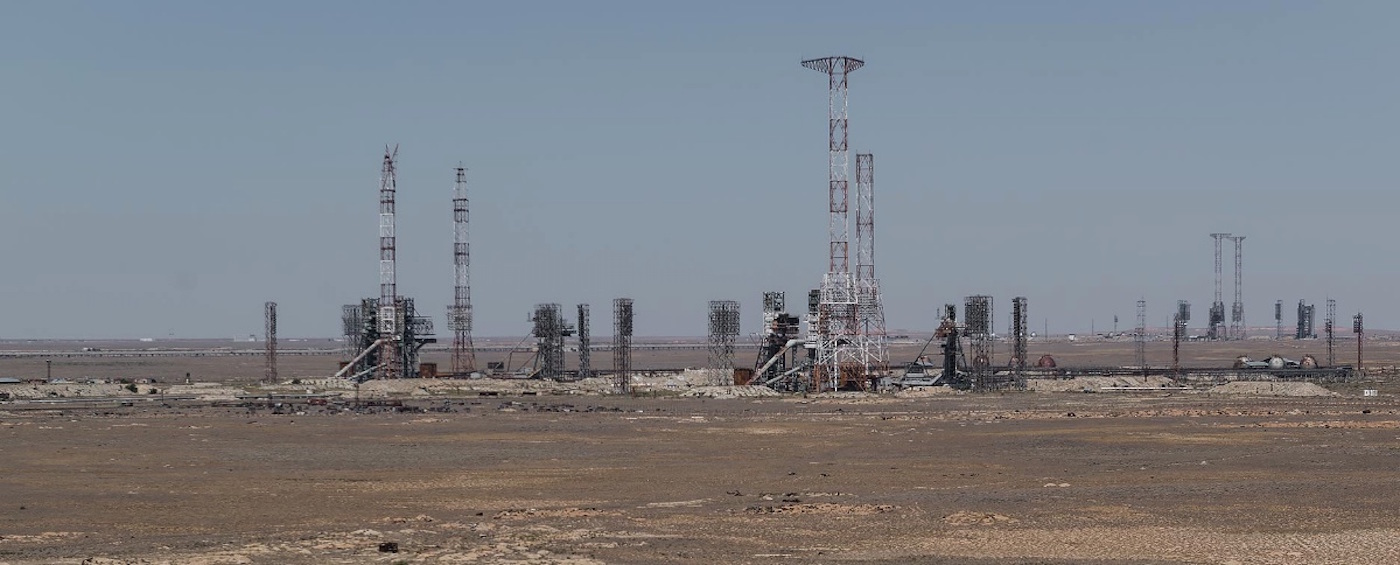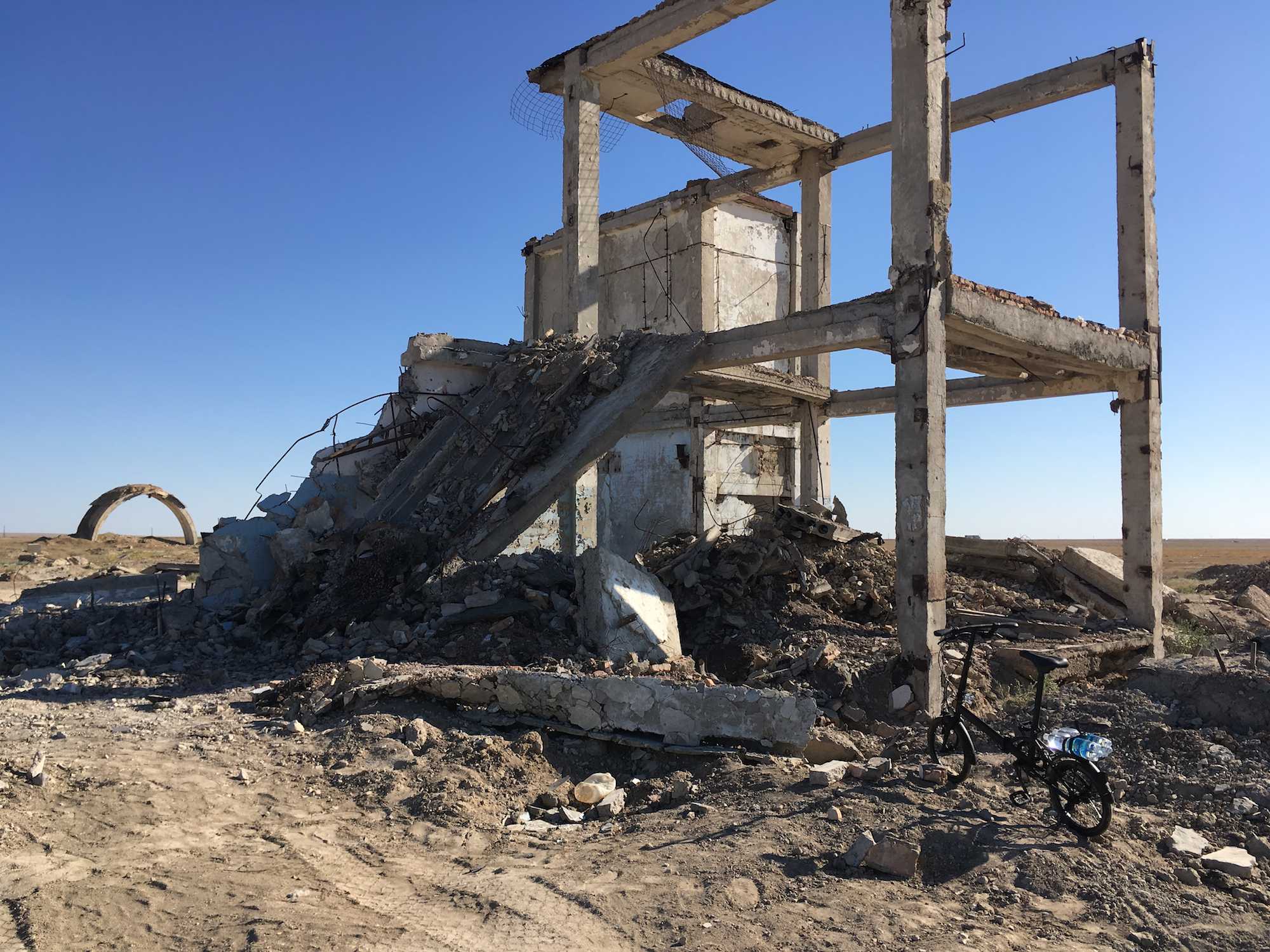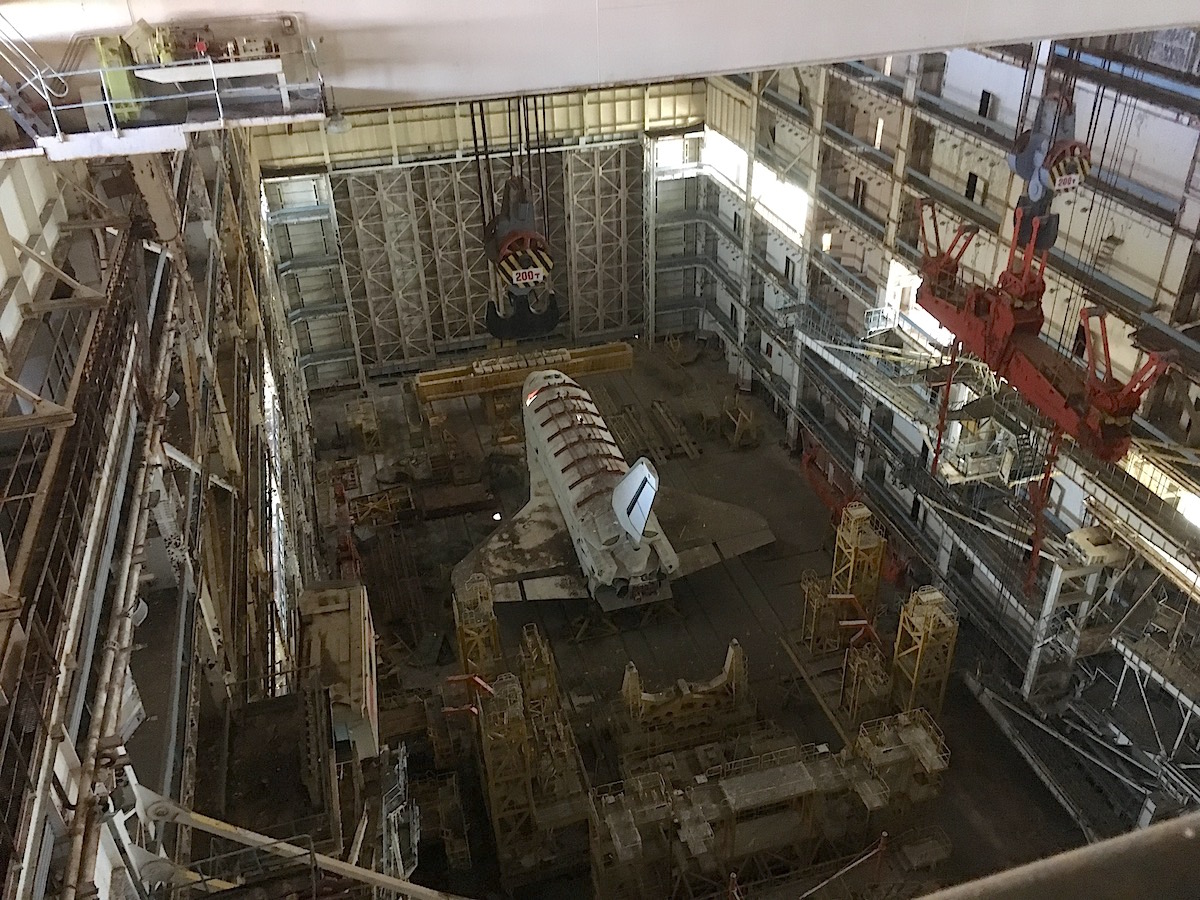This is a story from an anonymous photographer, as told to Julian Morgans
What you’re looking at is a derelict Russian space shuttle, covered in dust and forgotten in the bowels of a Kazak launch facility. It’s a remnant of the USSR’s failed effort at building a reusable space shuttle as part of the Buran Program. Based on plans stolen from NASA, the program chewed up untold billions between 1974 and 1993, only to briefly put one shuttle into orbit in 1988.
Videos by VICE
When the USSR collapsed, the program was mothballed and half-finished space shuttles were left rotting around the former Soviet empire. One shuttle was destroyed in 2002 when the hangar it was housed in collapsed in a storm, while another prototype is now housed in a German museum. These two shuttles at Baikonur Cosmodrome in southwest Kazakhstan are likely the only other survivors.
Only a handful of people have broken into this facility and got away with their SD cards. We’ll hear from one of those people today. He’s a European based urbex photographer who didn’t want his name published for fear it’d make international travel difficult, which is obviously part of his job.
Here, he explains in his own words how he got into the facility, how he got away, and how Russian agents have been on his tail since. The interview has been edited for clarity and brevity.

I first read about the Buran Program on the internet and I was like well, that’s going on my list. It just seemed like the climax for every urban explorer. The best of the best. So in October 2015, I travelled to Kazakhstan.
Now, the facility is huge. It’s about 70 kilometres by 90 kilometres of desert with hundreds of launch pads left over from the Cold War. A few of the launch pads are still active—it’s where they launch rockets at the International Space Station. But the main challenge is that the hangar is about 40 kilometres from the main road. Then the other problem is there’s nowhere to hide a car, so you can’t drive. And then on top of that there are jeeps constantly driving around on patrol.
I spent the 2015 trip watching with binoculars, just trying to learn where the patrols went and at what times. I had no plan. I just collected data trying to figure out how I’d avoid the patrols and get across the desert without a car, until I had this idea—a bicycle! Because once you’re inside you can ride your bicycle on the asphalt roads. I just had to cover the distance from the main road, to one of the inside roads, which is about 20 kilometres.
So I went back home and made a plan. I ordered a fold-up bike and kept an eye on the launches. You can check the launch schedule on the internet and I wanted a time when there’d be as little activity as possible. So then I saw that there weren’t any launches during August 2016. There was also a full moon in the middle of the month, which would make traveling at night easier. So that became the plan.

I flew in on the Friday night and at first it was easy. I found somewhere to hide my car—just a pile of old tyres, carpets, and trash in the desert. So I was covering the car in carpets and tyres, when this patrol car drove right past. And I was like, shit! But they must have thought I was unloading trash like the locals and they just kept going.
But still, I knew they’d changed their patrol route to see what I was up to. So I knew I had to make a new plan and I drove seven kilometres further east. There, on the following night, I found a cemetery where I figured I could park and nobody would ask questions.
From there I started cycling until I hit the first inside road. And this is where I found my first problem because I thought the roads were sealed, but they weren’t. Instead they were just sand and gravel but I had no other choice. So I started riding through the sand.
I thought it’d take five hours, but it was really hard work and took more like nine. By the time I got to the hangar it was dawn and I was exhausted, only to hit another problem.
The hangar was supposed to be unlocked but I found everything sealed up. I was like oh my god, I came here and now I can’t get in. But then I stacked some oil barrels up in a pile to reach the fire ladder and get up to the second story. The second story was unlocked so I got in about 6:30 AM and it was really dark. Just this single line of windows, casting a glow into what looked like an enormous cathedral. And then I could see these two amazing space shuttles sitting below me.

It was like a mausoleum for the space age. I sat there for two hours just looking at them. I tried to sleep but my body was full of adrenaline so finally around 10 AM, when the light got better, I started taking photos.
It was just a typical calm Sunday at Baikonur Cosmodrome and I spent all day climbing around, trying to get the best shots. The shuttles had clearly been rotting there for 25 years and they were covered in bird shit. There was a ladder beneath one of them and you could climb inside but there wasn’t actually much to see. They’re basically destroyed. Also the hangar is wrecked because of the 10-year period where the Kazakhs were unclear about what was happening at Baikonur and stripped the place. Everything of value has disappeared and I think the hangar will probably collapse, just like the other one.

After I spent the day taking photos I wanted to go see another hangar nearby. It’s the one with the big Energia rocket, about 400 metres away. So I crawled over and took some pictures. And then I was just about to leave when these three big Czar German Shepherds showed up. And they were making a lot of noise and one of the dogs was getting close so I grabbed a steel pole and got out my pepper spray, which I’d brought specifically for dogs. He was getting closer and closer, snapping at me, so I wacked him over the mouth and gave him a spray. After that all three backed off and I was alone again.
By this point it was dark and I had to get back. I didn’t want to be there on Monday morning so I needed to reach the car by daybreak. So I walked about eight kilometres back to my bike and started riding. Then all of a sudden I saw the lights of a jeep behind me. Quickly I threw my bike to the ground and ran about 50 metres into the desert.
I could see this guy coming down the road, careening right and then left, swerving into the desert and then back onto the road. I’m not sure if they were looking for me or what they were doing. But I guess it was the weekend, and these guards might have a few vodkas, and I was thinking please, god, don’t run over my bike. But somehow he drove right past and I got back onto the road and resumed riding.

After hours of riding through sand I was completely exhausted. Finally I figured it’d be just easier to walk so I ditched the bike and my bulletproof vest. So many times I wanted to lay down and rest but I knew I couldn’t. Waking up in the full sun of the desert without much water would be dangerous. I had six litres for 36 hours and that had worked out fine. But I knew it wouldn’t be fine in 37-degree heat.
Finally, about 6 AM, I got back to the car. I then drove about 20 kilometres away, turned up the air conditioner, and fell asleep. Then at noon I woke up again and kept going.
When I got home I had a big exhibition and the place was packed. I made great business and sold a lot of prints to business guys. The trip cost about 1,000 euros and I made 20,000 so it was a good profit.
But then four days later I came home to find the door of my condo open. Instantly I knew someone had broken in but it wasn’t the huge mess I expected. The only thing missing was my Nikon—the big Nikon which still had the rocket pictures on the card. And they stole my laptop too, but nothing else. I guess they were at the exhibition where they saw my computer projecting all the Baikonur pictures. But they left six lenses in the same camera bag, as well as my backup camera, the Sony A7. So it was like, a little weird.
I called the police and they came in and I made a statement. Later, they called me back and said, “Look, it doesn’t make sense these guys took only your camera and laptop. So, we think it might be a sign from Moscow.”

They told me to be careful because messing with those guys wouldn’t be fun. They thought, and I agree, that it’s was about honour. The Russians lose face when someone like me breaks into their top secret spaceport on a folding bike. And the Americans are paying tens of millions every time they use Baikonur to launch someone at the International Space Station, so it’s not good for business either. So since then, I’ve really tried to stay out of the media, which is another reason I’m being anonymous here.
I’m not scared. I haven’t been watching my back. I’m a very optimistic person and you have to be in this job. It’s a great story, and I’ve told it to a few friends already. I guess the main thing I learned was how important it is to be prepared. I had my pepper spray and my bulletproof vest. I learned the words for “hands up” in Russian. But I didn’t have a plan B prepared for when my first parking spot was foiled. I should have had a plan B ready to go but instead I had to improvise.
So always be well prepared and if anybody wants to go in there, my recommendation is don’t. I was even asked by a TV station to guide a team in there. They offered me a lot of money but I’m not a guide. I’m not going to go in there just for money. I do what I do for photography and not for anything else.
You can catch more stories from Julian on Twitter or Instagram




